Quick Look
Grade Level: 4 (3-5)
Time Required: 1 hours 30 minutes
(45 minutes on first day for initial demonstration and landfill models; 10 minutes per day for 3 days for observations; 5-20 minutes on last day)
Expendable Cost/Group: US $5.00
Group Size: 4
Activity Dependency: None
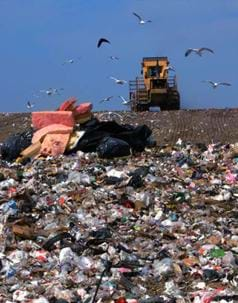
Summary
Student groups work as engineers to build and observe model landfills they make using two-liter plastic bottles. They come to understand the process and pitfalls of landfills as a waste disposal method.Engineering Connection
Decaying landfill garbage can produce harmful methane gas, which is a source of fires and environmental hazards. So, engineers design gas pipe systems to collect landfill gases, including methane, carbon dioxide and sulphur dioxide, which are used to generate electricity.
Learning Objectives
After this activity, students should be able to:
- Build a model of a landfill.
- Make predictions and observations of a model landfill over a four-day period.
- Explain some of the major cause and effect problems of landfills.
- Describe the role of engineers in landfill management.
Educational Standards
Each TeachEngineering lesson or activity is correlated to one or more K-12 science,
technology, engineering or math (STEM) educational standards.
All 100,000+ K-12 STEM standards covered in TeachEngineering are collected, maintained and packaged by the Achievement Standards Network (ASN),
a project of D2L (www.achievementstandards.org).
In the ASN, standards are hierarchically structured: first by source; e.g., by state; within source by type; e.g., science or mathematics;
within type by subtype, then by grade, etc.
Each TeachEngineering lesson or activity is correlated to one or more K-12 science, technology, engineering or math (STEM) educational standards.
All 100,000+ K-12 STEM standards covered in TeachEngineering are collected, maintained and packaged by the Achievement Standards Network (ASN), a project of D2L (www.achievementstandards.org).
In the ASN, standards are hierarchically structured: first by source; e.g., by state; within source by type; e.g., science or mathematics; within type by subtype, then by grade, etc.
International Technology and Engineering Educators Association - Technology
-
Explain why responsible use of technology requires sustainable management of resources.
(Grades
3 -
5)
More Details
Do you agree with this alignment?
State Standards
Colorado - Science
-
Create and evaluate models of the flow of nonliving components or resources through an ecosystem
(Grade
4)
More Details
Do you agree with this alignment?
Materials List
Needed for the demonstration:
- 2-liter plastic beverage bottle
- 1 standard party balloon
- ½ cup of raw ground beef
- 2 lettuce leaves, torn into small pieces
- 2 tbsp. sand, such as playground or landscaping sand
- 2 tbsp. water
- small length of string of any type, to tie around the bottle opening
- 3-4 inches of duct tape, to secure balloon around bottle opening
For the activity, each group needs:
- 2-liter plastic beverage bottle
- 1 tennis ball-sized mound of modeling clay; enough to line the inside of the top half of the 2-liter bottle
- 3 cups of soil
- ¾ cup water
- ½ sheet of paper, torn into small pieces; tip: use recycled paper from Activity 1 or newspaper
- 2 lettuce leaves, torn into small pieces
- 1 apple, sliced/diced into small pieces
- 2-3 plastic food containers, cut into small pieces about ½ inch square; tip: use empty butter or yogurt containers
- 8 pairs of rubber or latex gloves, 2 pair per student
- 2 spoons or popsicle sticks
- set of measuring cups, specifically, 1 cup, ½ cup and ¼ cup sizes
- 4 inches of masking tape, for labeling landfills
Worksheets and Attachments
Visit [www.teachengineering.org/activities/view/cub_environ_lesson04_activity2] to print or download.Introduction/Motivation
One way that we are able to learn something about ancient peoples is by studying their trash disposal methods, that is dumps vs. burying vs. other. We can discover a lot about the habits of and, specifically, the kind of people that used a certain dump by the types of garbage found there. In ancient times, humans placed garbage into big open pits and left it to rot. Now, garbage is frequently put in a landfill—basically, a huge, layered pile of trash. Modern-day sanitary landfills are generally lined with clay or plastic to prevent the leakage of toxic substances into the groundwater and soil. One way engineers work with solid waste is to improve the effectiveness and feasibility of landfill liners.
As garbage decays, landfills can also produce harmful methane gas, which poses a threat to the environment since methane gas can produce fires and other environmental hazards. Modern landfills are designed with a way to collect the methane gas that is produced. Often, elaborate pipe systems are designed by engineers and installed between the garbage layers. Often, the collected gas is used to supply households with energy, and other times, it is used as a fuel for internal combustion engines to generate electricity. Engineers are exploring better ways to collect the methane and more efficient ways to use it to produce energy (for homes, industry, etc.). Today, we are going to act as if we are engineers and build model landfills. We will add garbage to our landfill models and observe what happens as they are affected by rain, sun and the passage of time. What do you think will happen to our landfills?
Procedure
Before the Activity
- Ask students to bring in 2-liter plastic beverage bottles from home to use for the activity. Or, gather bottles from a recycling center. Tell students to wash each bottle and leave it to air dry, saving the caps. You will use them again in Activity 2 of Lesson 6. Cut each group's 2-liter bottle in half horizontally (keep the top section slightly larger). Twist the caps on securely (even over tighten them if possible).
- Pick a location to keep the model landfills during the observation period. Choose a place that receives sunlight, but where the odor will not be bothersome.
- Mix the food (lettuce and apples), the paper, and the plastic together into a "garbage" sample.
With the Students
Demonstration
- Place about 10 g of raw ground beef and the 2 lettuce leaves (torn into small pieces) into a cut off plastic 2-liter bottle. Note: Be sure to wear your gloves and wash your hands when this part is over!
- Carefully pour the sand into the bottle so that it covers the lettuce and meat. (Do not shake the bottle!)
- Slowly pour the water into the bottle. Make sure the water runs down the side of the bottle instead of directly onto the sand/lettuce/meat layers.
- Stretch the neck of the balloon tightly over the mouth of the bottle and secure it with the string and duct tape. (It will need to stay secure for 2-3 days.)
- Ask students to make predictions about what they think will happen in the experiment. Write the predictions on the white/chalk board.
- Put the bottle in a warm location where the students can observe it for 3 days. Explain to students that an observation is anything that stands out as important.
- Discuss the students' observations. (Possible observations: The material at the bottom of the bottle has begun to decay; methane gas forms during decomposition; the methane gas inflated the balloon.)
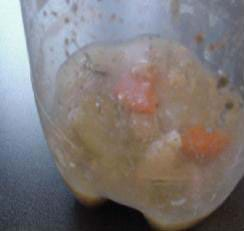
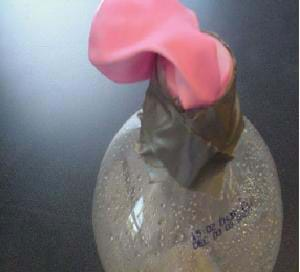
Activity
- Divide the class into groups of four, students each and distribute the supplies (activity sheets, soil, approximately ½ cup of the "garbage" sample, water, 2-liter bottles, clay, gloves, and masking tape).
- Ask each group to write the name of their group members on the masking tape and place it on the top portion (the neck end of the bottle) of the 2-liter bottle.
- Ask all students to put on their latex/rubber gloves.
- Ask the groups to line the inside of the top portion of the 2-liter bottle with clay, as in Figure 3. (Discuss how this is similar to the clay and plastic liners used in modern sanitary landfills to prevent toxins from leaching into the ground water.)
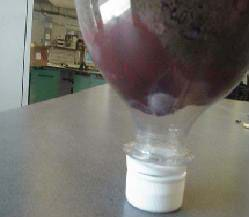
- Have students place the top portion of the 2-liter bottle upside down in the cut off bottom half of the bottle. (The bottom serves as a stand that will help keep the model upright.)
- Ask students to place about 2 cups of their soil inside the clay-lined "landfill."
- Have the groups spread their "garbage" sample on top of the soil (see Figure 4).
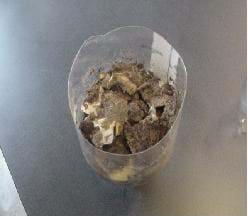
- Ask students to sprinkle their remaining soil on top of the "garbage."
- Have students sprinkle ¾ cup water over their landfill. (Note: Discuss that the water simulates rainfall. This concept will be discussed in more detail in Lesson 6.)
- On the accompanying activity worksheet, have students draw a diagram of their landfill and label it appropriately in Section I, Drawing.
- For the Prediction section of the worksheet, ask students to write down their predictions about what will happen with their landfill over the next 4 days.
- Place all the landfills in a location where they will get some sunlight yet where the odor will not be bothersome to the class (or others).
- On day two, observe the landfills as a class. Have students record their observations. Discuss what leaching is (i.e., in this case, a process whereby toxins leak into the soil/water as a result of rains or other moisture) and look for evidence of it in the landfills.
- Repeat the observation process on days 3 and 4. On day 3, have students sprinkle another ¾ cup water over their landfills.
- On the day 5, have students do the final steps and observations.
- After students have put on a pair of rubber/latex gloves, ask them to carefully remove the cap from the bottle and let the water drain into the bottom one-half of the 2-liter bottle. Ask them to record their observations.
- Ask the students to use the spoon/popsicle stick to gently scrape back the top layer of dirt. What do they notice about the garbage in their landfills? Ask them to record their observations.
- Use the "Numbered Heads" Assessment activity to discuss the results with student teams.
- Ask the students to work together as a team to complete the questions in the Response section of their activity worksheets. Use the Numbered Heads procedure to discuss answers.
Assessment
Pre-Activity Assessment
Prediction: After developing demonstration model, ask students to make predictions about what they think will happen in the experiment. Write the predictions on the board.
Observation: Have students record their observations of the demonstration model. Explain to students that an observation is anything that stands out as important. Discuss the students' observations. (Possible observations: The material at the bottom of the bottle began to decay; methane gas is formed during decomposition; and the methane inflated the balloon.)
Activity Embedded Assessment
Activity Worksheet: Have students follow along as directed in the "With the Students" Activity section of the Procedures.
Post-Activity Assessment
Numbered Heads: Use the "Numbered Heads" assessment activity to discuss results with student teams. Students on the team should pick numbers so each member has a different number. Ask the students a question from the list below (give them a time frame for solving it, if desired). The members of each team should work together on the question. Everyone on the team must know the answer. Call a number at random. Students with that number should raise their hands to answer the question. If not all the students with that number raise their hands, allow the teams to work on the question a little longer. Ask the following questions:
- Ask the students if they would drink this water. Would they use it for cooking? Would the use it for showers/baths or in their toilets?
- Would they feel differently if their landfill garbage had included toxic materials (like oil, gas, batteries, toilet cleaner, paint remover, etc.)?
- What has happened to the garbage in their landfills? (Answer: The garbage has decomposed and become very messy and smelly.)
- What do the results suggest about landfills? (Answers will vary, but may include: They are smelly, look bad, are bad for the surrounding area, etc.)
- Are landfills safe even with liners? (Answers will vary; encourage discussion.)
- Should we continue to use them? (Answers will vary; encourage discussion.)
- What do engineers do to make landfills safer? (Answer: Engineers work on designing better liners and storing/using the buildup of methane gas.)
Safety Issues
Students should not touch any of the materials in the demonstration or activity model landfills with their bare hands because of bacterial growth; students should be sure to wear rubber gloves during the demonstration and the activity.
Be sure to open the balloon from the demonstration in a well-ventilated place before disposing of it.
Be sure to wear gloves to properly dispose of the model landfill contents at the end of the activity.
Troubleshooting Tips
Keep the cleaned out 2-liter bottles, as you will use them again in Activity 2 of Lesson 5 and Activity 2 of Lesson 6.
Activity Extensions
Have students design a way to keep the "gas" from their landfill from escaping into the air.
Have the students investigate different types of soil for use in their model landfills.
Have students experiment with liners made of different materials.
Explore some of the student questions from the activity worksheet.
Lesson 5 addresses which items are biodegradable and which are not.
Lesson 6 addresses how chemicals leaching off our landfills affect our groundwater.
Activity Scaling
For 3rd grade students, set up the "landfill" before the activity. Place the "garbage" in it as a class demonstration and do the observations as a whole class activity. Or, consider using a "landfill" without a clay liner and one with a clay liner with holes (or other type of liner) in addition to the described "landfill," and compare the results of the experiments.
For 4th grade students, do the activity as is.
For 5th grade students, have each group investigate using a different type of liner or different type of soil. Compare and contrast the results. Hold a brainstorm session to decide what types of liners or soil to investigate. Also, try measuring in liters (L or ml) instead of cups.
Subscribe
Get the inside scoop on all things TeachEngineering such as new site features, curriculum updates, video releases, and more by signing up for our newsletter!More Curriculum Like This

In this lesson, students explore solid waste and its effects on the environment. They collect classroom trash for analysis and build model landfills in order to understand the process and impact of solid waste management.

In this lesson, students learn about the three methods of waste disposal in use by modern communities. They also investigate how engineers design sanitary landfills to prevent leachate from polluting the underlining groundwater.

Students construct model landfill liners using tape and strips of plastic, within resource constraints. The challenge is to construct a bag that is able to hold a cup of water without leaking.

Students investigate what types of materials biodegrade in the soil, and learn what happens to their trash after they throw it away. They learn about the concepts behind landfills and compost piles. In an associated activity, students create their own miniature landfills—a hands-on way to learn the ...
References
Bureau of Land Management – Environmental Education – Energy Activities, "It's A Gas," http://www.blm.gov/wo/st/en/res/Education_in_BLM/Learning_Landscapes/For_Teachers/science_and_children/energy/index/energy8.html
Copyright
© 2005 by Regents of the University of Colorado.Contributors
Amy Kolenbrander; Jessica Todd; Malinda Schaefer Zarske; Janet YowellSupporting Program
Integrated Teaching and Learning Program, College of Engineering, University of Colorado BoulderAcknowledgements
The contents of this digital library curriculum were developed under a grant from the Fund for the Improvement of Postsecondary Education (FIPSE), U.S. Department of Education and National Science Foundation GK-12 grant no. 0338326. However, these contents do not necessarily represent the policies of the Department of Education or National Science Foundation, and you should not assume endorsement by the federal government.
Last modified: August 3, 2020










User Comments & Tips